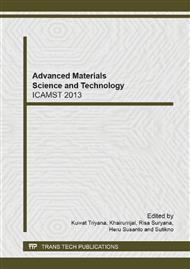p.687
p.695
p.701
p.706
p.710
p.714
p.718
p.722
p.726
Flaw Detection in Welded Metal Using Magnetic Induction Tomography
Abstract:
Various defects on welded metal can lead to failure of material, so that it needs some routine examination to maintain the material quality. The development of Magnetic Induction Tomography (MIT) in recent years made MIT a potential method for Non Destructive Test (NDT) to be applied in industries. We perform an MIT inspection technique to detect flaw using 2-coils MIT planar sensor that consist of transmitter and receiver coils which is able to detect flaw based on different electrical conductivity and measured as phase shift. This study involves experiment method with measurement of welded steel in two areas, there are normal and defective welded area which amounts to 72 measurement points that conducted with superposition principle. Then simulation of 2-coils planar sensor using Finite Element Method (FEM) software to obtain magnetic field sensitivity using parameter as in the experiment. Result from this measurement showed that phase value in normal welded area is higher than defective welded area, then those data is processed further on reconstruction step by using specific algorithm to obtain reconstructed image. This image able to show the presence of flaw in welded area which is indicated by red spot, and it has a relatively good correlation when compared with radiographic testing film.
Info:
Periodical:
Pages:
722-725
Citation:
Online since:
February 2014
Keywords:
Price:
Сopyright:
© 2014 Trans Tech Publications Ltd. All Rights Reserved
Share:
Citation:


